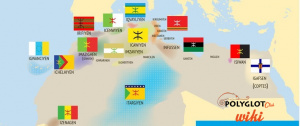Language/Kabyle/Grammar/Prepositions
| ◀️ Travel essentials — Previous Lesson | Next Lesson — Conjunctions ▶️ |
In this lesson, we will learn about prepositions in Kabyle. Prepositions are words that show the relationship between two words in a sentence. They usually indicate location, time, or direction.
Take some time to dive into these other pages after completing this lesson: Exam 2 Kabyle Noun & How to Use Be.
What are prepositions?
Prepositions are words that link nouns, pronouns, and phrases to other words in a sentence. They generally indicate direction, time, or location. Some common examples of prepositions in English are "in", "on", "under", "above", "with", "from", and "to".
In Kabyle, prepositions are used in the same way as in English. They are placed before a noun or a pronoun and help clarify the meaning of a sentence. Kabyle prepositions usually have a one-word form, although some exceptions exist. They act as simple connectors and are not inflected, meaning their form does not depend on the gender or number of the word they link.
Common Kabyle prepositions
Here are some of the most commonly used prepositions in Kabyle:
| Kabyle | Pronunciation | English |
|---|---|---|
| i | ([i:]) | to, for |
| di | ([di:]) | at, in, on, inside, within |
| seg | ([seg:]) | without, outside |
| yal | ([jal:]) | until, up to |
| deg | ([deg:]) | from, out of, off |
| as | ([as:]) | with, by, through, in |
| kra n teqvaylit | ([kra n tɛqvajlit:]) | in the Kabyle language (insert name of any language instead of Kabyle) |
| nnig | ([nniɣ:]) | like, as |
| werǧin | ([wɛrʒin:]) | among, between |
Examples of prepositions in sentences
Here are some examples of prepositions in Kabyle sentences:
- Daxuli-d yid-i di tallunt n waman. (I saw her at her mother's house.)
- Win yeqqeb di tniri dɣa sarsar-d s tallunt. (He who sleeps in the morning will find the door locked at home.)
- Hezzez-d yid-s i kra n umezruy. (She spoke to him in French.)
- Yella-d di wedlis s tallunt-is. (She arrived at the city with her mother.)
- As gulin ɣur-s laala. (They went with the boy to the mountain.)
- Fel-as deg yimezyazen-a. (He's gone from his friends.)
- Seg usayas n leqbayel, iqeddcen yenɣan deg werǧin-is. (In Kabylie, they eat bread among themselves.)
- Warni-yi-as kra n teqvaylit. (Explain it to me in Kabyle.)
Common prepositional phrases in Kabyle
In Kabyle, there are common prepositional phrases that are useful to know, such as:
- ɣef (with, in, on): ɣef ayen i d-yettili (with everything he said)
- ɣur (to, at, with): ɣur tallunt-iw (at my home)
- seg ul (without, outside of): seg ul nesɛa (without delay)
Conclusion
In conclusion, prepositions play an important role in linking words and phrases in Kabyle sentences. They generally indicate direction, location, and time. Prepositions in Kabyle are simple connectors that help clarify the meaning of a sentence, and they usually have a one-word form.
In the next lesson, we will learn about conjunctions and how to use them to connect words, phrases, or clauses in Kabyle sentences.
Having concluded this lesson, consider checking out these related pages: Nouns and gender & 0 to A1 Course.
Other Lessons
- Noun Gender
- Adjectives
- Adverbs
- Basic sentence structure
- How to Use Be
- Exam 2 Kabyle Noun
- Conditional Mood
- Future tense
- Negation
- Regular verbs
Sources
| ◀️ Travel essentials — Previous Lesson | Next Lesson — Conjunctions ▶️ |

